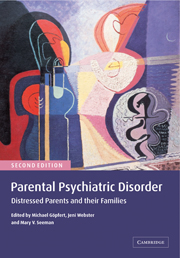Book contents
- Frontmatter
- Contents
- List of contributors
- Foreword
- Preface
- Part I Basic issues
- Part II Comprehensive assessment and treatment
- Part III Specific disorders: the impact on parent–child relationships
- Part IV Specific treatments and service needs
- Part V Child-sensitive therapeutic interventions
- 20 The child grown up: ‘on being and becoming mindless’: a personal account
- 21 Talking with children and their understanding of mental illness
- 22 Family therapy when a parent suffers from psychiatric disorder
- Part VI Models for collaborative services and staff training
- Afterword
- Index
- References
22 - Family therapy when a parent suffers from psychiatric disorder
from Part V - Child-sensitive therapeutic interventions
Published online by Cambridge University Press: 09 August 2009
- Frontmatter
- Contents
- List of contributors
- Foreword
- Preface
- Part I Basic issues
- Part II Comprehensive assessment and treatment
- Part III Specific disorders: the impact on parent–child relationships
- Part IV Specific treatments and service needs
- Part V Child-sensitive therapeutic interventions
- 20 The child grown up: ‘on being and becoming mindless’: a personal account
- 21 Talking with children and their understanding of mental illness
- 22 Family therapy when a parent suffers from psychiatric disorder
- Part VI Models for collaborative services and staff training
- Afterword
- Index
- References
Summary
Introduction
This chapter considers the following questions:
Why work with the family?
Who is the family to be worked with?
What are relevant approaches to treatment?
What are the goals of treatment?
Why work with the family?
Family therapy with patients with mental illness has progressed from an assumption and/or hope that a change in the relationship patterns of the individuals in the family could ‘cure’, for example schizophrenia, to an evidence-based model in which family members are helped, in a collaborative manner, to develop more effective and less intrusive problem-solving techniques. These techniques focus on positive ways to respond to the illness associated with the behaviour of the patient.
The important differences in these two approaches are discussed below. Neither approach has specifically considered the need to help patients in their role of parent. Also, to our knowledge, neither the outcome studies aimed at lowering relapse rates of patients with schizophrenia or bipolar disorders, nor studies targeting family burden (Magliano et al., 1999; Perlick et al., 2001) have addressed the adverse effects of illness on dependent children nor how parents with mental illness can be helped to mitigate such effects.
Whilst being mentally ill is both painful and lonely for the sufferer, involving, as it does, a ‘loss of mind’ as well as a reliable sense of ‘self’, living with such a person may be extremely traumatic for a vulnerable child (Moltz, 1993; Pearlmutter, 1996).
- Type
- Chapter
- Information
- Parental Psychiatric DisorderDistressed Parents and their Families, pp. 306 - 322Publisher: Cambridge University PressPrint publication year: 2004
References
- 3
- Cited by



